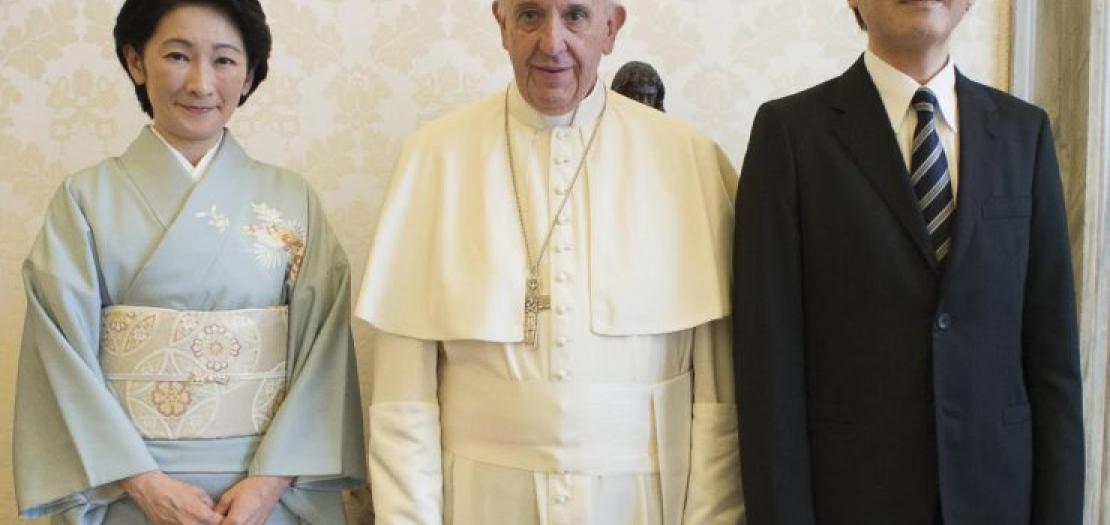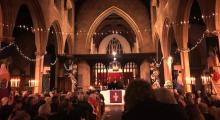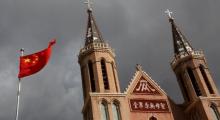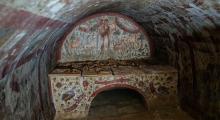Issued by the Catholic Center for Studies and Media - Jordan. Editor-in-chief Fr. Rif'at Bader - موقع أبونا abouna.org

“These are the roots of the Church in Japan, roots that have nourished its uneasy existence, which still nourish her life and give hope for the future.”
In an in-depth interview with ZENIT, Xavian missionary Sister Maria De Giorgi, an expert of interreligious dialogue of the Shinmeizan Centre for Interreligious Dialogue in Japan, explored this. While in these days with the President of South Korea visiting the Pope and speculation that a papal visit to the Koreas may not be as far-fetched as one could have thought, especially given that Pope Francis has said he wishes to visit Japan in 2019, we decided to take a closer look at Japan.
We spoke to Sister Maria in Bologna, Italy, on the sidelines of the 32nd meeting in the Spirit of Assisi, Oct. 14-16, started by St Pope John Paul II in 1986 and continued by the Community of Sant’Egidio, where representatives of different cultures, faiths and religions joined together to build “Bridges of Peace.” She was one of those intervening in the panel “Japan: Religions and Value of Life.”
Sister Maria is also a theologian and scholar of Japanese spiritual thought is also consultor of the Commission of the Japanese Episcopal Conference for interreligious dialogue and lecturer at the Pontifical Gregorian University in Rome.
In the interview, she reflects on the history of the Church in Japan, its martyrs, what the Pope would find there if he makes this hoped-for visit in 2019, including its Catholic community, as well as the interreligious and intercultural dialogue in which she was participating in the northern Italian city. Here is our interview:
***
ZENIT: Saint Pope John Paul II was a great bridge builder. Tomorrow will be the 40th anniversary of his election as Pope. How can John Paul II be an example of building bridges of peace and dialogue today, after so much time and so many historical events?
Maria De Giorgi: I believe that the example of St. John Paul, as that of all the true Greats of history, is everlasting and can inspire courageous choices also for today. His “times” were certainly not easier than the present ones, or devoid of challenges: suffice it to think of the tragedy of World War II, of the invasion of Poland by the Nazis and the Soviets and of all that implied for his country and for the world. We find an echo of all this in his book “Memory and Identity,” in which he proposes a dramatic reflection on the mystery of evil that goes across history, “mystery that in the 20th century, “brief century and the most violent of history” (E. J. E. Hobswam) manifested itself with an unheard-of cruelty. Suffice it to think of the Holocaust, of the gulags, the mass exterminations, etc. And yet, John Paul II never lost confidence in history — which he knew and believed is guided by God –, and in man, whom he recognizes as creature of God, made in His image and likeness. And it’s from this, his granite faith, that he taught us — with words, gestures and above all with his life — that evil never has the last word. Saint John Paul II’s work could not be understood without taking into account his faith in God and in man, which enabled him not only to build bridges but also to pull down walls! Today also, if we truly want to pull down walls and build bridges we have no other way. Man is by nature “person,” “relationship” called to a fullness of love, which only God can bring to fulfilment. Humanity will only be able to grow in peace by discovering that it is one community, that it has one origin and one ultimate end — God, as Nostra Aetate states. And Saint John Paul II taught this authoritatively.
ZENIT: Why is it important to build bridges with other religions? Why is an encounter, like this one of Sant’Egidio, helpful?
Maria De Giorgi: Again in Nostra Aetate, Vatican II affirms that “ Men expect from the various religions the answer to recondite enigmas of the human condition, which today as yesterday profoundly trouble man’s heart: man’s nature, the meaning and end of our life, good and sin, the origin and purpose of pain, the way to attain true happiness, death, judgment and sanction after death, finally, the last and ineffable mystery that surrounds our existence, from whence we derive our origin and towards which we tend.”
The religious dimension is constitutive and intrinsic to the human being. The existence of the various religions is an irrefutable proof. Every man, whether he wishes or not, is called to confront himself with “the ultimate and ineffable mystery that surrounds our existence, from where we derive our origin and towards which we tend.” In the journey towards the fullness of the encounter with the Mystery, the answers of the various religions — as the Council states — cannot be trivialized. In fact, they enclose “treasures” that can be shared and can help in understanding the Great Mystery that exceeds us. That is why encounter and dialogue with other religions is fundamental. It was no accident that Saint Paul VI, the great Pope of dialogue, said: “the transcendent origin of dialogue is found in the intention itself of God” (Ecclesiam Suam).
I like to recall how a great prophet and teacher of dialogue, H.E. Monsignor Pietro Rossano, liked to repeat that dialogue between religions doesn’t exist, but between persons of different religions. Dialogue is, first of all, an encounter, a looking at one another in the eyes, acknowledging one another, speaking to each other, confronting one another loyally <and> sharing. The great value of Sant’Egidio’s Meetings is precisely this. In these 30 years of journeying, it’s not the religions that “engaged in dialogue” abstractly. It is men and women of different religious traditions that have met one another, known each other, confronted one another, learned to esteem each other and love one another despite the differences; they have prayed next to one another experiencing a new and real fraternity. It’s only by beginning from these premises that we can truly build a more just world, a true peace that isn’t just a pause between one war and another. I’ve been taking part in these Meetings for 30 years, and I have lived personally their richness and fruitfulness, and I can be a witness of this. Thanks to the commitment of Sant’Egidio Community, the “spirit of Assisi” has put down firm roots and will certainly bear its fruits.
ZENIT: What have been your greatest takeaways from this encounter? What are you bringing to it — if you had to say the main message of your intervention here (your main message)?
Maria De Giorgi: As I said shortly before, the greatest “treasure” of these inter-religious gatherings is the personal encounter between persons of different cultures and religions; the familiarity that is experienced, the joy of seeing ourselves different but always closer, of discovering ourselves friends, brothers, desirous of exchanging gifts and of enlarging the area of “dialogue,” committing ourselves, according to our respective responsibilities, to have “dialogue” — as Saint Paul VI taught prophetically — become truly an attitude of the heart and of the mind, a natural way of relating to one another, whoever the other may be, to address the differences and difficulties, to assume shared responsibility in the quest for the common good. There is certainly much work to be done in this direction, but as Saint John Paul II already wrote, “dialogue is a way towards the Kingdom and it will surely bear its fruits, although the times and moments are reserved to the Father” (RM 57).
ZENIT: Some expect the Pope to visit Japan in 2019 — do you? What would you expect from such a visit?
Maria De Giorgi: As a missionary living in Japan for over 30 years, I’m certainly very happy that the Holy Father is likely to visit this country. Pope Francis’ creativity certainly surpasses every expectation of ours. I know that there are many who desire this visit. Japan is also not living an easy juncture. The only country wounded twice by the atomic bomb, many expect from Pope Francis words and gestures of peace, a clear and strong denunciation against the atomic threat and every form of violence. And then, the Japanese Catholic Church, although always a small minority in this great country, will certainly draw comfort and incitement from this visit of Pope Francis. Saint John Paul II’s visit, the first Pope to visit the Land of the Rising Sun, had a great impact on the life and mission of the Church in Japan. I think Pope Francis’ visit won’t be less so.
ZENIT: What will the Pope find in Japan? How does one observe the Catholic faith there? Tell us something about its Catholic community.
Maria De Giorgi: The Pope will find a country that lives many of the contemporary contradictions. It’s difficult to summarize in a few words the situation of the Japanese Church, heir of a history of martyrdom and of minority, but also of hidden heroism.
The Catholic Church is a small minority: about 450,000 Japanese Catholics and the same number or perhaps even greater of Catholic immigrants especially from the Philippines, South America and other countries, sown in a population of 127 million inhabitants. The challenges that this community must address today are numerous: the growing process of secularization, which touches all religions and that brings with it what is described as “shukyo banare,” “estrangement and disaffection” with religion; a phenomenon that touches, although in different ways, all the religious Traditions present in the country. Added to this is the problem of the low birth rate and of an ageing population problem that touches the entire Japanese society and, consequently, also the Church.
ZENIT: How are relations there with non-Catholics? We know Catholics make up a small minority…
Maria De Giorgi: At present, relations between the Catholic Church in Japan and members of other religions are good, be it at the ecumenical level, be it at the inter-religious level. The complex Japanese religious panorama is very heterogeneous: besides Shintoism, Japan’s native religion, we have the different Buddhist Schools and the so-called new Religions. In regard to Christianity, in addition to the presence of the Catholic Church, we have that of the Orthodox Church, of Anglicans and Protestants.
Although in different measures, I would say that the relationship between these realities is positive. Notable steps have been taken, be it at the ecumenical level, be it at the inter-religious <level>. There are numerous initiatives and organizations that seek to foster dialogue between these components, be it at the grassroots level, be it at the institutional level. Within the Japanese Episcopal Conference there is a Sub-Commission for Interreligious Dialogue and one for Ecumenism, which has worked actively for years to foster dialogue and good mutual relations.
Among the events at the national level that most manifest this atmosphere, one can recall the so-called “Summit of Religions,” organized by Tendai Buddhism that every year on mount Hiei (Kyoto) proposes again the event of Assisi, in a similar way as Sant’Egidio Community does in Europe.
ZENIT: The Pope’s visit to Japan will bring to light, especially, the incredible story of the Japanese Christian martyrs. This history has even inspired a famous movie. Why does this history deserve to be known also outside of Japan? For someone unfamiliar, can you briefly share about this history . . . these martyrs.
Maria De Giorgi: Yes, Japan has a long and glorious history of martyrdom. After the rapid successes of the first evangelization, initiated by Saint Francis Saverio in 1549, and lasting for more than 50 years without serious difficulties, persecution ripped through the young Christian community with unheard of ferocity. The first martyrs — Jesuits, Franciscans and Franciscan Tertiaries, among whom were some who were very young — were crucified at Nagasaki on February 5, 1597. Beatified by Pope Urban VIII in 1627, they were canonized by Pius IX in 1862.
With the worsening of the persecution, between 1617 and 1632 a good 205 Christians — nobles, simple citizens, men, women and children; fathers and mothers of families, priests and men religious — endured a cruel martyrdom. Some were tied to stakes and burned by slow fire; others were decapitated or quartered member by member, while their remains were dispersed to prevent devotion to the martyrs. Pius IX beatified them on July 7, 1867.
Then we have the group associated to Saint Dominic’s Order (Priests, Religious Brothers, Consecrated virgins and laymen of various nationalities among whom were nine Japanese) killed between 1633-1637, after having sown the seed of the Gospel in the Philippines, Formosa and Japan. Beatified at Manila by Saint John Paul II in 1981, they were canonized by him at Rome in 1987. Another 188 martyrs were beatified at Nagasaki in 2008. Added to them is nobleman Dom Juston Takayama Ukon, beatified at Osaka on February 7, 2017.
In addition to these martyrs, whose death in witness of the faith was documented in a rigorous canonical process, are thousands upon thousands of those that witnessed with blood their faith in Christ. It’s a glorious history that deserves to be better known, not only in Japan. Because of this long, bloody and systematic persecution, the few surviving Christians took refuge in remote places, especially in smaller Islands off the coast of Nagasaki (the so-called “kakure Christian” or “hidden Christians”), where they survived, handing down the faith and Baptism, without the assistance of priests or other ministers, for a good seven generations, until 1865, when some European missionaries were able to return to Japan. However, then also, when they came out into the open presenting French missionary, Father Bernard Petitjean of the Foreign Missions of Paris, there was a new wave of persecutions. Only in 1872, also following international pressures, the death penalty for Christians in Japan was abrogated definitively.
These are the roots of the Church in Japan, roots that have nourished its uneasy existence, which still nourish her life and give hope for the future.







